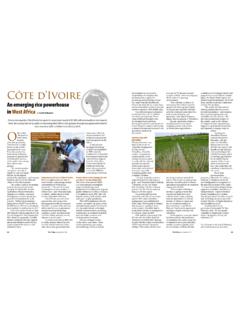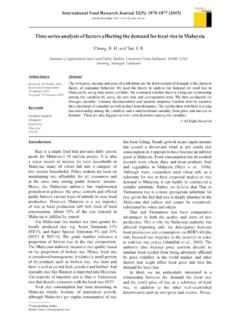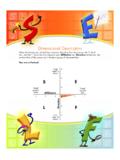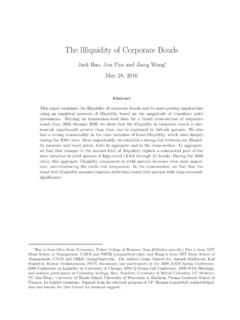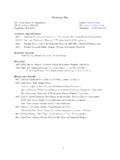Transcription of Lessons from the world food crisis of 2006–08
1 T H E S T A T E O F F O O D I N S E C U R I T Y I N T H E W O R L D 2 0 1 121 Lessons from the world food crisis of 2006 08markets during the While transmission is often weak in normal times, transmission was stronger during the world food annual averages, in 2008 domestic prices (adjusted for inflation) in the same sample of countries as used in Figure 5 were on average 28, 26 and 26 percent higher for rice, wheat and maize, respectively, than in 2007. Although much less than the changes experienced on world markets, these increases would have had a substantial impact on the purchasing power of the poor. In countries such as Bangladesh, Malawi and Viet Nam, the poor often spend 35 percent or more of their income on staple foods; since total food is about 70 percent of total expenditures for the bottom quintile (see Figure 4, p.)
2 14) staple foods thus account for about half of total food expenditures for the poorest 20 percent of the population. Thus, in 2008, poor consumers who did not produce There has been substantial discussion of what happened (and why) on world food markets between 2006 and 2008 (and more recently, in 2010 and 2011). The OECD-FAO Agricultural Outlook provides a review of these But the degree to which world price movements are transmitted to domestic prices is a critical issue, because neither farmers nor consumers interact directly with world markets. In other words, the impacts of world prices (in terms of both levels and volatility) on poverty and food security are mediated through the price transmission mechanism.
3 This section of the report focuses on what happened to prices on domestic markets during the world food crisis of 2006 08. How have domestic prices for staple foods changed since 2006?Key messageDomestic food prices increased substantially in most countries during the world food crisis ; the exceptions were some large countries that were able to insulate themselves from world markets. But trade insulation increased prices and volatility in international markets, making domestic price increases in small import-dependent countries larger than they otherwise would have world witnessed large increases in the prices of rice, wheat and maize on international markets during the food crisis of 2006 08.
4 In most cases, the surges in prices on international markets led to substantial increases in domestic prices, although domestic prices did not increase in some countries (see What is the impact of trade policies on price transmission? , pp. 22 4). By July 2008, domestic rice, wheat and maize prices were each, on average across countries, about 40 percent higher (after adjusting for inflation) than they were in January 2007 (Figure 5). Other studies have also reached the conclusion that there was substantial transmission of prices from world markets to domestic Domestic prices for rice, wheat and maize increased substantially during the crisisFIGURE5 Note: The graph shows average inflation-adjusted trends in domestic prices for rice, wheat and maize across countries from January 2007 to December 2010.
5 The domestic price is set equal to 100 in January 2007 for all countries, and the index value for subsequent months is equal to the average index value across all countries. The domestic price indices for rice, wheat and maize include 42, 27 and 34 countries, respectively, and include all countries for which data were available at the time of of raw data: FAO Global Information and Early Warning (January 2007 = 100)2007 2008 2009 2010T H E S T A T E O F F O O D I N S E C U R I T Y I N T H E W O R L D 2 0 1 122 Lessons from the world food crisis of 2006 08staple foods experienced a decline in real income of approximately 9 percent (equal to the budget share of 35 percent multiplied by the price increase of about 26 percent).
6 Not surprisingly, the average volatility of domestic prices also increased during the crisis , reaching a peak for all three cereals in 2008 (Figure 6).After the collapse of international cereal prices in the second half of 2008, domestic prices eventually began to decline in most countries. By the second quarter of 2010, domestic prices (after adjusting for inflation) had largely returned to January 2007 levels for wheat and maize. Domestic rice prices remained at somewhat higher levels, however, with prices on average 20 percent higher than in January 2007. The pattern of changes in domestic prices across cereals was similar to that on world markets, as world rice prices increased the most between January 2007 and the second quarter of the second half of 2010 and the first half of 2011, however, world prices for wheat and maize doubled due to wheat crop damage in the Russian Federation and a subsequent export ban, as well as poor growing conditions for the maize crop in the United States of America and a weakening dollar.
7 Notably, world rice prices were much more stable during this period. Transmission of these shocks to domestic markets varied from country to country, although it is too early to draw general conclusions. The next section of the report describes the conditions under which world price shocks are transmitted to domestic economies, as well as how trade can mitigate the impact of domestic supply shocks on price volatility. What is the impact of trade policies on price transmission?Key messageRestrictive trade policies can protect domestic prices from world market volatility but can also result in increased volatility as a result of domestic supply shocks. In many instances, unpredictable government policies are a more important cause of domestic price volatility than world market price transmission from world markets to domestic markets is affected by several factors, including transport costs, countries levels of self-sufficiency, exchange rates and domestic shocks.
8 But trade policy is perhaps the most fundamental determinant of the extent to which world price shocks pass through to domestic markets. Trade policy interventions were relatively common in developing countries during the world food crisis , with at least 55 countries using trade policy instruments to mitigate the impacts of the world food crisis of 2006 particular, the key factor that affects price transmission is the degree to which the government determines the volume of trade (either exports or imports), as opposed to allowing the private sector to make the decision. Government control might be applied formally, through a fixed quota, or informally, through ad-hoc determination of quotas that vary in response to external events.
9 Export quotas can reduce pass-through of high world prices to the domestic economy, while import quotas can prevent the pass-through of very low world example, during the world food crisis of 2006 08, domestic prices of rice and wheat were very stable in China, India and Indonesia because of government controls on exports of these crops (see Figure 7 for China).44 These controls are in place even in normal times and were not implemented specifically in response to the crisis . It is important to note that while trade controls in China did prevent transmission from world markets, China has maintained a generally open trade policy in the sense that domestic rice prices are at most times similar to those on world markets the government does not systematically force domestic rice prices to be above or below world prices.
10 On the other hand, domestic prices of soybean in China surged in 2007 and 2008, because the government does not control trade in that commodity (Figure 8). In addition, China imports a large share of the soybean it consumes, so export restrictions would be course, not all government trade controls lead to more stable and predictable prices (Box 6). Malawi, for example, arranged for exports of maize in 2007/08 and 2008/09, but domestic supplies were not sufficient to support exports and Volatility of domestic prices for rice, wheat and maize peaked in 2008 FIGURE6 Note: Volatility of domestic prices is calculated as the standard deviation of the logarithm of (Pt/Pt-1), using monthly data.










